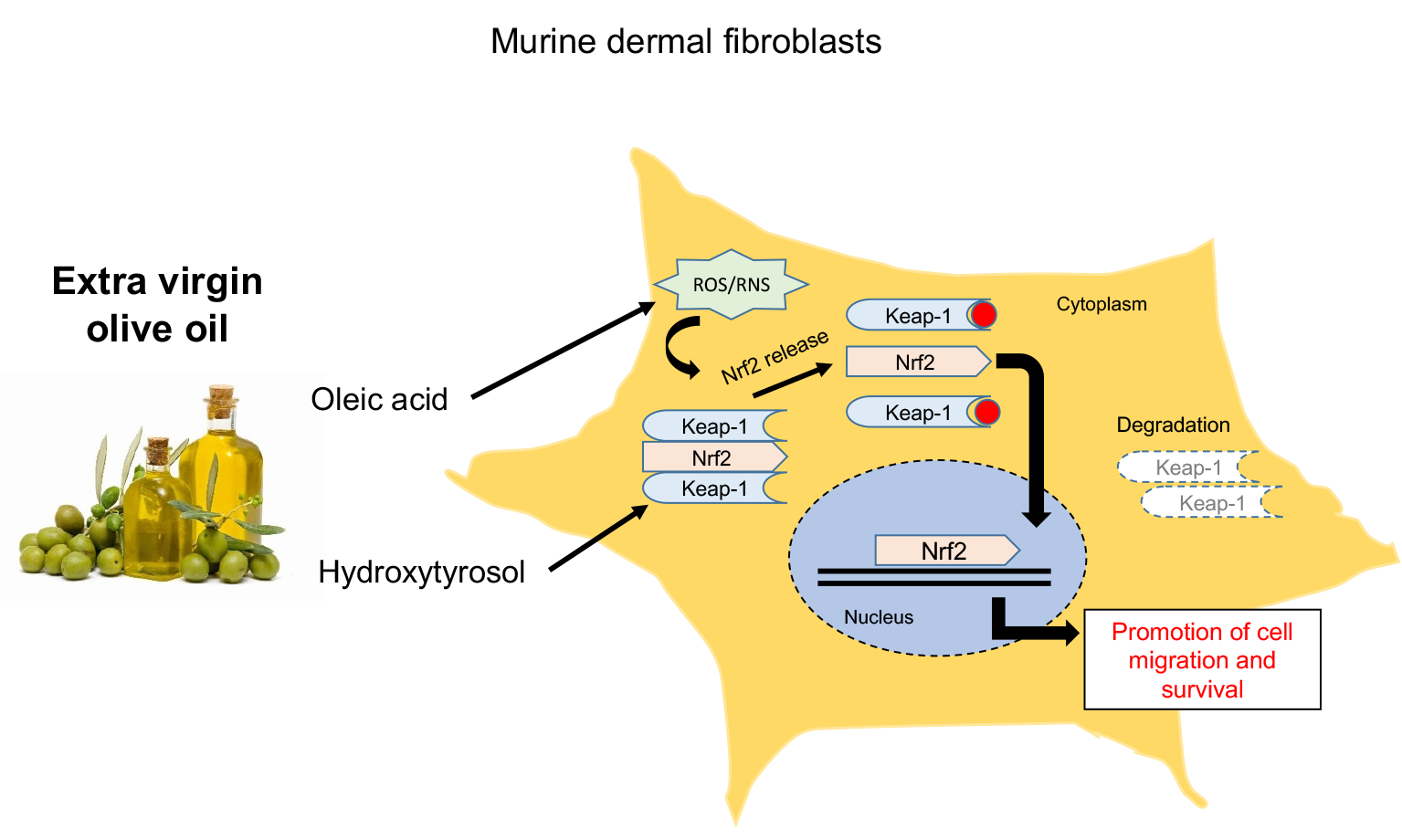By Bruna Romana-Souza

Graphical Abstract: Hydroxytyrosol and oleic acid-induced reactive nitrogen species promotes the activation of the Nrf2 pathway leading to a promotion of fibroblast survival and migration that are essential for the resolution of wound healing.
Extra virgin olive oil (EVOO) is the main source of vegetable fat in the Mediterranean diet and is associated with lower risks of cardiovascular diseases and diabetes (1). The olive oil is a mixture of 75-80% oleic acid (a monounsaturated fatty acid, C18:1 n- 9) and 1-2% phenolic compounds (hydroxytyrosol), which gives it antioxidant and anti-inflammatory proprieties (2). Our group have reported that oral administration of EVOO improves cutaneous wound healing of pressure ulcers and reduces the signs of aging in mouse skin and ex vivo human skin (3, 4, 5). The beneficial effects of EVOO in chronic wounds and premature aging are associated with its capacity of reducing inflammatory response and oxidative damage (3, 4, 5). Recently, we have demonstrated that oleic acid present in EVOO activates signaling pathways associated with inflammation and oxidative damage during the normal process of wound healing (6). However, hydroxytyrosol present in EVOO directly promotes Nrf2 pathway associated with antioxidant and anti-inflammatory responses in wound healing process (6). These data were very interesting because no study has described yet this dual effect of EVOO during skin tissue repair. To understand this, we performed a study that was recently published (7). In this study, we treated dermal fibroblasts isolated from mouse skin with EVOO, oleic acid, or hydroxytyrosol. We choose the fibroblast from skin because they are the main cell type involved in the resolution of wound healing. We observed that oleic acid present in EVOO stimulates the production of reactive oxygen species (ROS) and reactive nitrogen species (RNS), which promotes the activation of Nrf2 pathway in dermal fibroblasts (Figure). In addition, hydroxytyrosol present in olive oil directly stimulates the activation of the Nrf2 pathway in dermal fibroblasts (Figure). The activation of Nrf2 induced by both compounds of EVOO promotes the transcription of many factors, which stimulate the migration and survival of dermal fibroblasts (Figure). Thus, we showed that the activation of the Nrf2 pathway by EVOO enhances the functions of the cell type that is essential for the resolution of the wound healing process. These findings are crucial to understanding the mechanisms involved in the beneficial effects of olive oil on skin wound healing.
Read all at: https://aocs.onlinelibrary.wiley.com/doi/10.1002/lipd.12363

Bruna Romana-Souza is an Associate professor of Department of Histology and Embryology at the Rio de Janeiro State University (UERJ) in Brazil, where she received her Master’s degree and her PhD degree in Experimental Biology. She was a professor and researcher at UERJ from 2012 to present. She teaches “Human Histology and Embryology” for the Bachelor’s Degree in Nursing and is a member of the Doctorate Committee of the PhD Program in “Experimental and Clinic Physiopathology”. She is a supervisor of bachelor’s, master’s and doctoral theses. The results of her research have been published 45 papers on international journals and 1 chapter on international books (h-index: 18; 875 citations). She has been a referee for ISI journals belonging to top-decile/quartile in her research area. She is a member of the Editorial Board of Wound, Repair, and Regeneration. She was an evaluator of the research activity of the National Council for Scientific and Technological Development and an international referee of the Medical Research Council. She has collaborated with national (Federal University of Rio de Janeiro) and international (University of Illinois Chicago) Universities and Research Centers.
References:
- Alkhatib A, Tsang C, Tuomilehto J. Olive oil nutraceuticals in the prevention and management of diabetes: from molecules to life- style. Int J Mol Sci. 2018; 19:1-13.
- Visioli F, Bellomo G, Galli C. Free radical-scavenging properties of olive oil polyphenols. Biochem Biophys Res Commun. 1998; 247: 60-64.
- Donato-Trancoso A, Monte-Alto-Costa A, Romana-Souza B. Olive oil-induced reduction of oxidative damage and inflammation promotes wound healing of pressure ulcers in mice. J Dermatol Sci. 2016; 83: 60-69.
- Romana-Souza B, Monte-Alto-Costa A. Olive oil reduces chronic psychological stress-induced skin aging in mice T through the NF-κB and NRF2 pathways. J Func Foods. 2019; 54, 310-319.
- Romana-Souza B, Monte-Alto-Costa A. Olive oil inhibits ageing signs induced by chronic stress in ex vivo human skin via inhibition of extracellular-signal-related kinase 1/2 and c-JUN pathways. Int J Cosm Sci. 2019; 41: 156-163.
- Romana-Souza B, Saguie BO, Nogueira NPA, Paes M, Valença SS, Atella GC, Monte-Alto-Costa A. Oleic acid and hydroxytyrosol present in olive oil promote ROS and T inflammatory response in normal cultures of murine dermal fibroblasts through the NF-κB and NRF2 pathways. Food Res Int. 2020; 131: 108984.
- Ribeiro CCS, Faria RVC, Nogueira JS, Valença SS, Chen L, Romana-Souza B. Olive oil promotes the survival and migration of dermal fibroblasts through Nrf2 pathway activation. Lipids 2022; 1-10.

